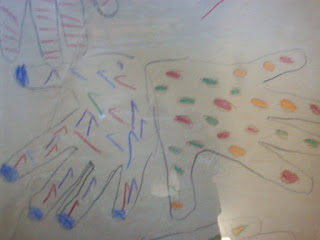An art therapy piece where color is used to depict feelings.
At a loss for words? Have no words to describe how you're feeling? No words can express how you feel? I've heard all these statements at one point or another in my professional and personal life. I'm tempted to reach into my bag and pull out a doodle pad and markers and reply, well, would an image or drawing help or a scribble? How about a collage or clay piece? As I like to say, when in doubt, doodle. Some thoughts can not always be expressed with words or staying in one's linear brain. It might be beneficial at this time to tap into the nonlinear brain or emotional Brain. I believe many of life's problems can not be solved with our left or analytical brains. Yes, balancing our check books requires the left brain and building a computer or putting together a bicycle calls for the thinking brain, but when it comes to life's more challenging events such as the loss of a loved one, losing a job or friendship, calling on our thinking Brain will usually get us nowhere. Because when we try to think our way out of events like this, we avoid the feelings that reside inside of us. Whether you call it a spiritual approach or creative approach, using our feeling brains allows us to move into the direction of healing much easier than with words alone. It might not be an image that comes to mind when experiencing a loss, but it might be a color, shape or size that expresses how we are feeling. I always recommend that before trying any art therapy exercise, that you be working with a trained art therapist and/or be in a safe place in case strong feelings do come up. I will recommend a person allows the page to hold their grief where their heart can rest for a moment. Lets say, you've lost your job that you've had for many years. You find it difficult to put words to what you are feeling and you might be feeling many feelings. Begin by choosing a color that represents how the experience is making you feel. If you have conflicting feelings, choose all the colors that come to mind. Let the pastels guide you across the page. You might even want to close your eyes as you move the pastel around the paper. There might be times you want to press harder on the pastel or softer. You might want to move all over the page or stay in one spot. Let your feelings be the guide. I suggest pastels because you can blend them with your finger. When you feel you are finished, sit with the art for a moment and reflect on the process. You might want to write in your journal about the process. In closing, I also suggest keeping a art and writing journal during times of change, transition and loss as they can be a powerful healing tool. I recommend reading The Artist's Way by Julia Cameron, Rituals of Healing, Using Imagery for Health and Wellness by Jeanne Achterberg, Barbara Dossey, & Leslie Kolkmeir, and Opening Up..The Healing Power of Expressing Emotions by James W. Pennebaker. Be well in body, mind and spirit.

